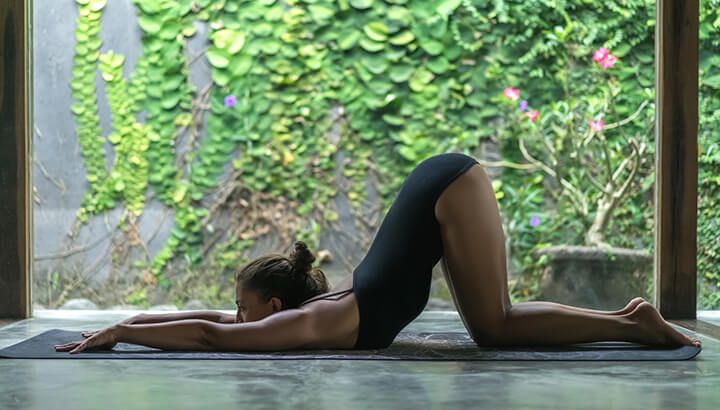Few things are more frustrating than trying to fall asleep and not being able to. If you experience this regularly, you might be living with insomnia, which brings fatigue, anxiety and illness with it.
Insomnia can be caused by a number of physical and psychiatric conditions, from depression and anxiety to a lack of exercise, certain medications and chronic illness. In some cases, it may be tied to a problem with the brain — some people’s brains may not be able to establish a wake-sleep cycle efficiently! More common causes include seasonal allergies, stress, gastrointestinal issues like acid reflux, asthma, hyperthyroidism and low back pain.
The good news is, by adding a few yoga poses to your nightly routine, you might be able to treat and eventually overcome your insomnia.
Extended puppy pose
Like its big brother, downward facing dog, extended puppy pose brings all the benefits of an inversion (like headstand) without the difficulty. This pose is great for balancing the body after a long day at work. It relieves tension in the upper body and encourages fresh blood flow to the heart.
Start on all fours, with your hips stacked over your knees. Walk your hands forward on the mat. Lift your elbows but keep your forehead down, aimed toward the mat. You should be in a pose that looks like a hybrid of downward facing dog and child’s pose, with your hips raised above your knees, but your head down toward the mat with your arms extended forward.
To transition out of this pose, settle your hips back on your heels for child’s pose, or try supported child’s pose, described below.
Supported child’s pose
If you practice yoga, you know how restorative and comforting child’s pose is. Now, imagine you’re doing it while cuddling a pillow. Sit on your knees with your rear on your heels. Position one or two stacked pillows with the narrower part between your knees. Lean forward and rest an ear on the pillow, with your eyes closed, your jaw and belly relaxed.
You can cuddle the pillow if that feels comfortable or allow your arms to rest on the bed or mat beside it. Take this time to notice your breath as it moves the belly in and out against the pillow. This comforting pose will signal to your brain that it’s time to settle down and relax for the night.
Reclining bound angle pose
This pose is perfect for practice on your yoga mat or once you’ve crawled into bed. You’ll need two pillows or yoga blankets for this pose as it’s all about restoration and relaxation.
Lie flat on your back and bring the soles of your feet together with your knees bent, so they resemble a butterfly’s wings. Place one pillow (or yoga blanket) under each thigh and place your hands on your stomach. Close your eyes, relax your face and jaw, and bring your awareness to your breath and place your hands on your belly. They should be moving up and down with the movement of your breath.
Stay in this pose for as long as you’d like, giving your hips a gentle stretch and allowing your mind to settle.
Legs up the wall
This is perhaps one of the best yoga poses you can practice – in fact, my yoga teacher told me that if I can only practice one pose a day, legs up the wall is it!
Start on the floor or your bed, sitting on your side with one hip against the wall. Then turn so that you’re lying on your back and your rear is near or against the wall. Extend your legs up the wall and let your arms fall comfortably to the floor or bed. Lie in this position for as long as you’d like — up to 15 minutes — and let the tension fall away from you.
This pose helps reset the nervous system and can help rid you of anxiety, digestive problems, migraines and possibly symptoms of mild depression.
Corpse pose
You might be wondering how corpse pose is any different than simply laying down in bed. Well, to start, the pose encourages you to focus on your breathing so you can eliminate those pesky thoughts that keep running through your mind. It also settles both the body as it settles the mind, making it primed for sleep.
To practice corpse pose in bed, lie on your back and rest your hands by your side or on your stomach. If you need more back support, place one or two pillows beneath your knees to bring your lower back to the bed. Gently close your eyes, relax your jaw and focus on your breath. Notice how it expands your rib cage and then, when you exhale, how your belly and ribs release. Complete several rounds of these belly breaths as you drift off to sleep.
Practice one — or all — of these yoga poses before bed to counteract any insomnia you might have to get a better night’s sleep. Once you start getting a good night’s sleep on a regular basis, you’ll find other things in your life become easier, too!
Do you practice yoga before bed? Let us know which poses you love in the comments!

